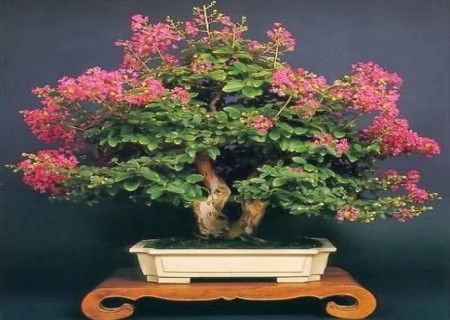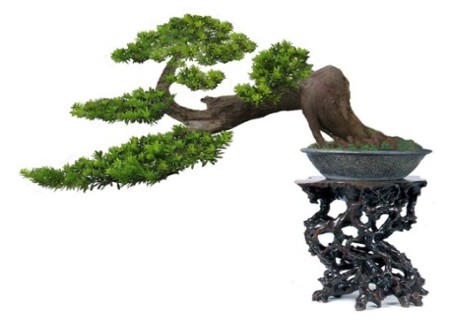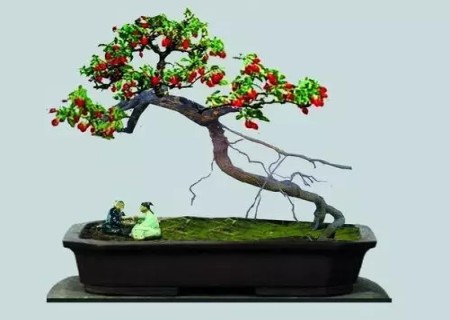Bonsai production technology of crape myrtle stump
There are many kinds of crape myrtle, and the mentality is different, more importantly, with the change of the season will be changed into different posture and color, is a very beautiful tree species. In addition, crape myrtle has strong branches, dense leaves and twigs, bare roots and stems, so it is of high ornamental value to use it to make bonsai. Every blooming season, crape myrtle flowers are in full bloom, and the blooming crape myrtle bonsai will be displayed in front of people in a charming manner.

So, how to make crape myrtle bonsai? In fact, crape myrtle bonsai is relatively easy to make, let's follow the editor to learn crape myrtle stump bonsai production technology!
1. Bonsai materials
We can obtain crape myrtle bonsai material by grafting, and the crape myrtle pile head propagated in this way is easier to plant and survive. In addition, we can also get it by digging old piles in the field. Generally, it can be excavated during the early spring of October. When digging, try to choose strange-looking stumps, first cut out the main roots and trunks, and then dig small roots, and be careful not to damage the roots as much as possible.
2. Old pile treatment
Dig the crape myrtle down the mountain pile to do a simple clean-up. First of all, cut off the withered branches and leaves, but also thinning branches and cutting leaves to remove redundant branches. At the same time, it is also necessary to trim the roots, especially the overlong ones. The soil at the root should be preserved and compacted.
3. Raising billet with tree stump
The treated downhill piles are planted on the ground or directly in temporary pots. If directly implanted into the pot, the soil in the basin should be fertile, loose and ventilated, and the old crape myrtle root system should resume growth and sprout many new branches before transplanting in the pot.
4. Upper basin transplantation
Choose a good pot before putting on the pot, depending on the shape of the plant. Then the cultivated old pile will be dug out again, and after a little treatment, it can be implanted into the new basin for planting. After placing the old pile, fill in the loose and breathable humus soil, then compact the soil close to the old pile, and finally pour water for the last time. After pouring the root water and then covered with a layer of sand, it can be placed in the shade for normal management.
5. Trim styling
After the old crape myrtle pile turns into normal growth, it can be trimmed and styled. The growing season focuses on pruning, cutting off overdense branches and leaves and branches that affect shape. In the aspect of plastic surgery, it should be carried out according to the design ideas of the creators. For the pruning of ordinary branches, 1-2 buds are usually retained for each branch, and the long branches are removed in time. In addition, in order to prevent crape myrtle from bearing fruit, the remaining residual flowers should be picked in time after the flowers fade. Through the above measures, we can not only make crape myrtle bonsai blossom many times a year, but also make its branches thicker and shorter, so as to improve the ornamental.
6. Maintenance and management
The maintenance and management of crape myrtle bonsai is mainly water and fertilizer management. Due to the rapid evaporation of water in the growing season, it is necessary to ensure timely watering and keep the basin soil moist for a long time. However, in the initial stage of crape myrtle growth, it is necessary to properly control the water, not a large number of irrigation. The purpose of water control is to ensure its normal growth, but also to make the branches grow thicker and the leaves smaller, so it is easier to control the shape. Flowering and summer water consumption is larger, so it is necessary to increase watering efforts. For fertilization, organic fertilizer is mainly applied in the growing season; foliar fertilizer is sprayed before and after budding; some organic fertilizer can also be added after flowering.
For the crape myrtle bonsai that has been made, it only needs to be pruned and reshaped properly, and the posture can be corrected, and the basin can be turned over and changed after 2-3 years. After the stump is removed from the basin, part of the old soil should be removed, the branches and roots that are too dense should be trimmed, and after finishing, they should be implanted into the new basin. Then fill in the new soil, compact the soil and pour enough water.
After the completion of the above procedures, crape myrtle bonsai can be transferred to the normal daily maintenance management. Has everyone learned it? Bonsai friends who like delicate and colorful crape myrtle bonsai might as well try to make their own crape myrtle bonsai according to the above operation method.
Time: 2019-05-26 Click:
- Prev

Techniques for Making Podocarpus Pine Bonsai
Bonsai is an important element to beautify the home environment, and pine bonsai upright posture and smooth lines undoubtedly give people the enjoyment of the United States. The old pine pile is simple, magnificent and indomitable spirit, which gives people positive motivation. Especially against the backdrop of rocks, it is green and incomparable, and the atmosphere is extraordinary.
- Next

Cultivation techniques of Chinese wolfberry potted landscape
Lycium barbarum stump bonsai posture elegant, hanging branches, purple flowers and red fruits, is a plant of great ornamental value. But to turn ordinary wolfberry into bonsai requires a long period of careful cultivation by bonsai artists, but one thing is certain.
Related
- Fuxing push coffee new agricultural production and marketing class: lack of small-scale processing plants
- Jujube rice field leisure farm deep ploughing Yilan for five years to create a space for organic food and play
- Nongyu Farm-A trial of organic papaya for brave women with advanced technology
- Four points for attention in the prevention and control of diseases and insect pests of edible fungi
- How to add nutrient solution to Edible Fungi
- Is there any good way to control edible fungus mites?
- Open Inoculation Technology of Edible Fungi
- Is there any clever way to use fertilizer for edible fungus in winter?
- What agents are used to kill the pathogens of edible fungi in the mushroom shed?
- Rapid drying of Edible Fungi

